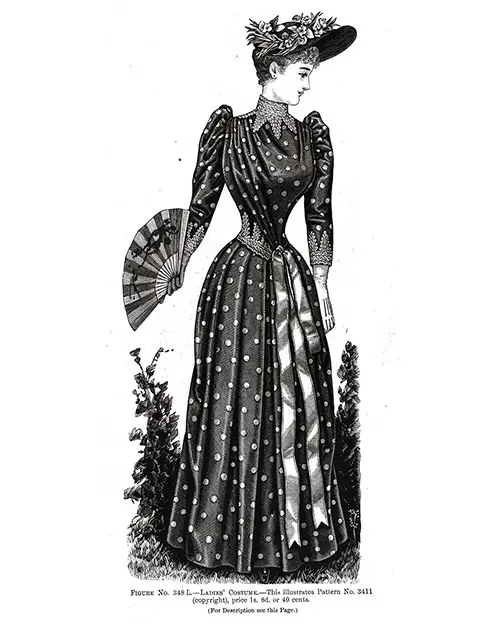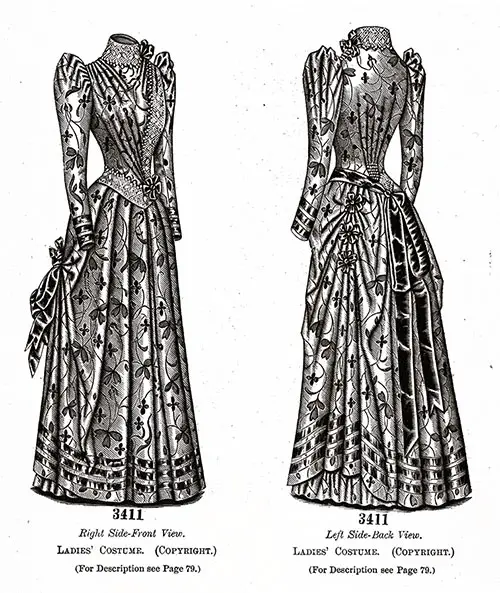Ladies Costume 348 L - 1890

The costume represented here is developed in spotted India silk, with Vandyke lace and ribbon for decoration. The skirt is in the popular four-gored style and a small bustle may be worn if desired.
Overhanging the skirt to the lower edge Is a full drapery that is arranged in forward-turning plaits at each side of the center of the front, back of which a shallow, back- ward-turning plait is laid.
The back is drawn by gathers, and a belt finishes the top. The drapery is lifted stylishly at each side by upward-turning plaits, and the skirt is disclosed for a short distance at the bottom far back at the sides.
The stylish basque has a fancy front that is adjusted over the right fitted front of lining and lapped over the left front, which is similarly fitted, the closing being made invisible.
The fullness of the fancy front is collected in gathers at each shoulder edge, and also at the lower edge for a short distance back of the closing, producing soft, pretty folds.
A full back, which is drawn closely by shirrings at the waistline, is arranged over a fitted back of lining, and underarm gores complete the adjustment.
The lower outline is pointed at the front and back and well arched over the hips. An upward-turning row of Vandyke lace decorates the lower part of the basque at the right side, and at the lowest point of the closing is secured a bow of ribbon, the ends of which reach nearly to the bottom of the skirt.
At the neck is a standing collar, which is decorated with Vandyke lace, the points of which rest upon the basque; and the leg-o’-mutton sleeves are gathered at the top and arranged over coat-shaped linings, the wrists being trimmed with Vandyke lace.
Costume Options
The costume will develop beautifully in a great variety of dress fabrics, such as Surah, India or China silk, Bengaline, figured or plain cashmere, imperial serge, brilliantine, and camel-hair.
Vandyke-point lace or passementerie, moiré, grosgrain or velvet ribbon or any preferred garniture may be added.
When ribbon is selected, several rows of it may be arranged at the lower part of the drapery, and rosettes of ribbon may be very effectively placed at the top and bottom of the closing and over the plaits at each side.
The basque may also be trimmed effectively with ribbon, which may be arranged in diagonal rows at the fronts and encircle the sleeves all the way to the elbow.
The stylish straw hat is prettily wreathed with flowers.
Illustration and Pattern Information
Figure No. 348 L.—This illustrates a ladies’ costume. The pattern, which is No. 3411 and costs Is. 8d. or 40 cents, is in thirteen sizes for ladies from twenty- eight to forty-six inches, bust measure, and is shown again on page 80 of this Delineator.
Ladies’ Costume No. 3411.

No. 3411.—Spotted India silk is pictured in this costume at figure No. 348 L (above) in this Delineator, with Vandyke lace and ribbon for decoration.
In the present instance, the costume is represented made of figured challis, and white lace and ribbon supply the garniture.
The skirt is fashioned in the regulation four-gored style, and a small bustle may be worn if desired. Over the skirt is arranged a full drapery, which is hemmed deeply at the bottom and decorated with three rows of ribbon.
The drapery is disposed in four forward-turning plaits at each side of the center of the front, back of which at each side is laid a shallow, backward-turning plait; and the fulness at the back is regulated by gathers, a placket opening being made at the center.
The drapery is lifted at the sides by upward-turning plaits, which are tacked to the skirt and arranged to produce contrasting effects.
At the right side three plaits are made some distance below the top under a rosette and loops and ends of ribbon; at the left side near the top five upward turning plaits are made, and three rosettes are ornamentally placed on this side of the drapery.
The lower part of the skirt is trimmed with a gathered flounce that is prettily revealed where the drapery is lifted at the sides.
The fancy front of the stylish basque is arranged upon fitted fronts, completely concealing the right fitted-front and lapping diagonally over the left.
Shirrings regulate the fullness of the fancy front in the shoulder and lower edges, the lower shirring drawing the fullness toward the front side, with surplice effect; and tackings made to the fitted front hold the fulness well forward, while a dart taken up with the second dart in the under front produces a smooth effect at the side.
The closing is made invisible. The back is seamless at the center, and a pretty fullness is collected in rows of shirring below the waist-line, the fulness above the shirrings flaring to produce the effect of a French waist.
The back is arranged on a lining fitted by a center seam and side-back gores, and underarm gores complete the adjustment.
The standing collar is overlaid with lace, which also decorates the lower and closing edges of the fancy front and is continued along the right side of the basque to the center of the back.
The lower part of the basque at the left side is followed by ribbon, which starts from beneath a rosette at the bottom of the closing and terminates under loops and ends of the ribbon, which reach nearly to the bottom of the skirt at the center of the back.
A rosette of ribbon is ornamentally placed at the top of the closing of the fancy front. The leg-o’-mutton sleeves are arranged over coat-shaped linings; the tops are drawn by gathers, and each wrist is ornamented with three rows of ribbon.
Costume Options
The costume is very picturesque yet straightforward in effect and will develop beautifully in all kinds of soft silks and woolens, such as Surah, India or China silk, cashmere, Henrietta cloth, challis, nun’s vailing, crepon, and various other dress fabrics.
For dressy occasions, lace net or flouncing will make up charmingly, and pretty colored silk may be used for the skirt, with dainty effect.
Pattern Information
We have pattern No. 3411 in thirteen sizes for ladies from twenty-eight to forty-six inches, bust measure.
To make the costume for a lady of medium size will require twelve yards and three-fourths of material twenty-two inches wide, or ten yards and an eighth, twenty-seven inches wide, or seven yards and five-eighths thirty-six inches wide, or six yards and an-eighth forty-four inches wide.
Price of pattern, 1s. 8d. or 40 cents.
"Figure No. 348 L.—Ladies’ Costume," in The Delineator: A Journal of Fashion, Culture, and Fine Arts – Midsummer Number, New York: Butterick Publishing Co., Ltd, Vol. XXXVI, No. 2, August 1890, P. 76+ (For Illustrations see Page 76).
"Ladies’ Costume [No. 3411]," in The Delineator: A Journal of Fashion, Culture, and Fine Arts – Midsummer Number, New York: Butterick Publishing Co., Ltd, Vol. XXXVI, No. 2, August 1890, P. 79-80 (For Illustrations see Page 80).
Note: We have edited this text to correct grammatical errors and improve word choice to clarify the article for today’s readers. Changes made are typically minor, and we often left passive text “as is.” Those who need to quote the article directly should verify any changes by reviewing the original material.
